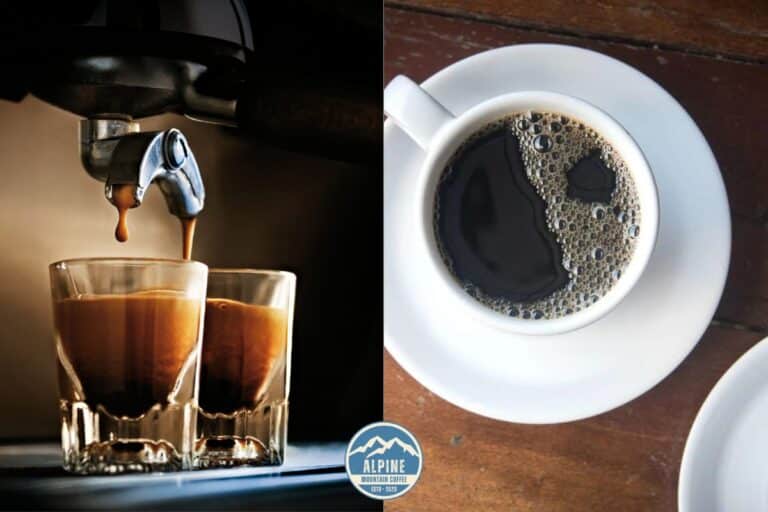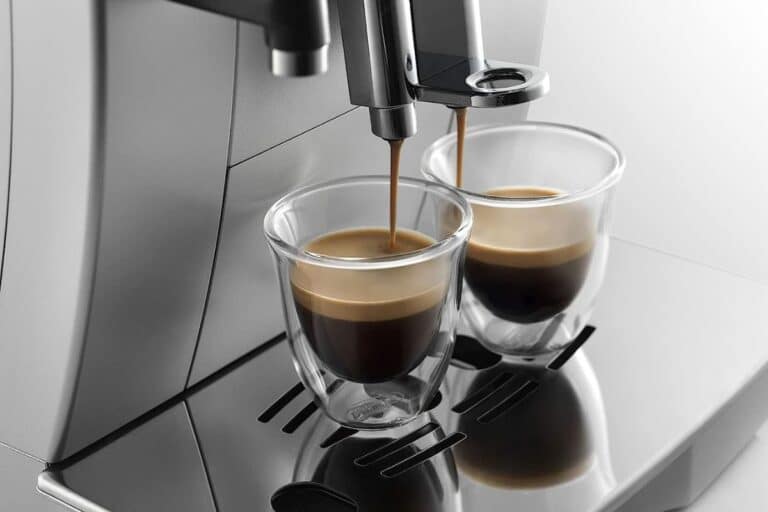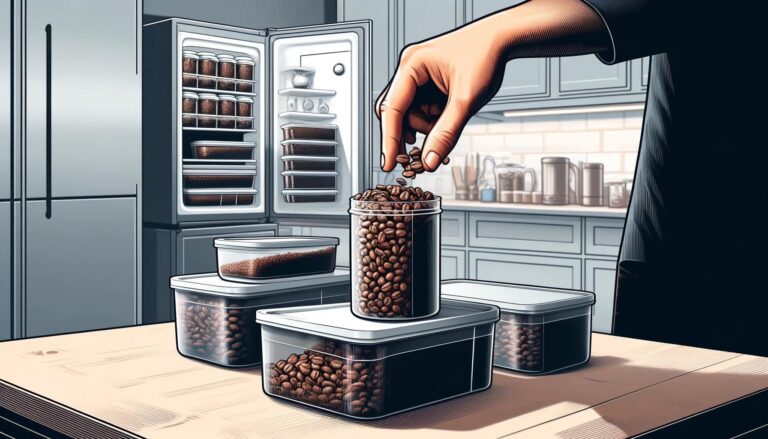Alan Adler, an engineering instructor at Stanford University and the inventor of the Aerobie flying ring, invented the AeroPress in 2005. He wanted to invent a coffee brewing device that could make a single cup of coffee that was rich and full of flavor. Adler aimed to combine the best parts of espresso and French press coffee while cutting down on bitterness and acidity. The AeroPress, known for its simple, efficient design and the excellent coffee it makes, really stands out.
The AeroPress is a small, durable device made of BPA-free plastic. It has a chamber and a plunger with a filter cap at the bottom for the coffee grounds. Its clever design lets hot water and coffee grounds mix under gentle air pressure, making the extraction process faster and less bitter. This method makes smooth, tasty coffee in about a minute, which coffee lovers and beginners both enjoy.
Coffee enthusiasts all over the world have quickly become big fans of the AeroPress since its launch. Its success comes from not just the quality of the coffee it makes but also its versatility, affordability, and ease of use. There’s a global community of AeroPress users who exchange brewing tips, recipes, and techniques, always finding new ways to use this device.
The AeroPress Championships, which started in 2008, show how much people love this coffee maker. These yearly contests bring people from all over the world who want to show off their brewing skills and new recipes. The competition emphasizes the AeroPress’s special role in the coffee community, bringing together people who love to experiment with this unique coffee maker.
In short, the AeroPress is more than a coffee maker; it’s a movement that has changed the way we think about brewing coffee. Its creation was a big moment in coffee culture, offering a new way to look at brewing a great cup of coffee. With its wide popularity and active community, the AeroPress keeps encouraging coffee fans to discover new possibilities in their coffee brewing adventures.
What is an AeroPress?
The AeroPress is a versatile and portable coffee brewing device invented in 2005 by Alan Adler, allowing for a wide range of coffee styles through simple adjustments in brewing time, temperature, and coffee-to-water ratios. Its design consists of a cylindrical chamber and plunger, using a rapid, pressure-driven process that produces coffee with rich flavor and low acidity in about one to two minutes.
The Design of the AeroPress
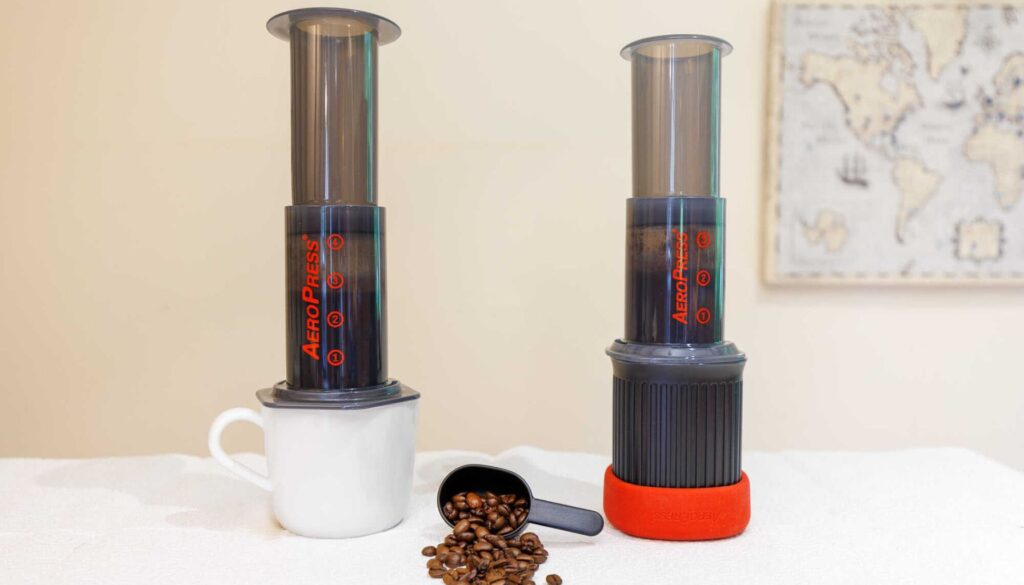
The AeroPress is a testament to thoughtful design and functional simplicity, catering to the needs of coffee enthusiasts seeking both quality and convenience. Its construction and assembly reflect a harmonious blend of durability and user-friendly design, distinguishing it from other coffee makers in several key aspects.
Materials and Durability
The AeroPress is crafted from polypropylene, a robust and lightweight plastic known for its durability and resistance to high temperatures. This choice of material ensures that the AeroPress is not only safe to use with hot liquids but also durable enough to withstand the rigors of daily coffee brewing. Additionally, it is BPA-free and phthalate-free, addressing health and safety concerns associated with plastic products. The robust construction of the AeroPress means it is less likely to break or deteriorate over time, unlike glass or ceramic coffee makers that are more prone to cracking or breaking.
Components and Assembly
The AeroPress consists of a few key components that assemble with elegant simplicity:
- Chamber: The main body where the coffee grounds and hot water are mixed.
- Plunger: Fits snugly into the chamber, used to press the water through the coffee grounds and filter.
- Filter Cap: Screws onto the bottom of the chamber, holding the paper or metal filter in place.
- Filters: Typically paper, though reusable metal filters are also available for those seeking a more eco-friendly option.
- Stirrer and Scoop: Accessories included to assist in the brewing process.
The design is intentionally straightforward, making the assembly and brewing process intuitive. Users add coffee grounds and hot water into the chamber, stir, then insert the plunger and press down, forcing the brewed coffee through the filter and into a cup. This direct immersion and rapid filtering process is not only efficient but also allows for fine control over the brew strength and flavor.
How it Differs from Other Coffee Makers
The AeroPress distinguishes itself from other coffee makers through its unique brewing method and design. Unlike drip coffee makers that rely on gravity to pass water through coffee grounds, the AeroPress uses air pressure, resulting in faster extraction and a smoother taste. It offers a cleaner cup than a French press, which typically leaves some sediment due to its coarser filter. Compared to traditional espresso machines, the AeroPress is far more affordable and portable, requiring no electricity and minimal space.
Its versatility is another defining feature; it can produce a wide range of coffee styles, from rich espresso-like concentrates to lighter American-style coffee, all controlled by the grind size, water temperature, and pressing time. The simplicity of its design also makes it incredibly easy to clean, typically requiring just a rinse under running water.
In summary, the AeroPress’s design philosophy revolves around simplicity, durability, and versatility, setting it apart from other coffee makers. Its ability to produce high-quality coffee, combined with ease of use and maintenance, has cemented its popularity among coffee lovers around the world.
How the AeroPress Works

The AeroPress employs a unique brewing method that combines air pressure with immersion brewing, resulting in a rich, smooth coffee. This innovative approach not only optimizes extraction but also allows for a high degree of customization, catering to various taste preferences. Here’s a closer look at how the AeroPress works, including the step-by-step brewing process and an exploration of the role of air pressure in extraction, as well as variations in brewing techniques such as the traditional and inverted methods.
Step-by-Step Brewing Process
- Preparation: Assemble the AeroPress with its filter cap and a paper filter; rinse the filter with hot water to remove any paper taste and preheat the chamber.
- Add Coffee: Place the AeroPress on top of a sturdy mug or cup and add finely ground coffee into its chamber. The recommended starting point is about 17 grams (or one rounded scoop) of coffee for a standard cup.
- Add Water: Pour hot water (ideally at 175°F to 185°F for optimal extraction) into the chamber, filling it up to the desired level based on the coffee’s strength preference.
- Stir: Use the included stirrer to mix the coffee and water for about 10 seconds, ensuring all the grounds are fully saturated.
- Insert Plunger: Place the plunger into the chamber and gently press down with steady pressure. The brewing and pressing process should take about 20 to 60 seconds, depending on your preference for brew strength.
- Enjoy: Once the coffee has fully filtered through into the cup, remove the AeroPress, and your coffee is ready to enjoy.
The Role of Air Pressure in Extraction
The AeroPress utilizes air pressure created by pressing down on the plunger to force water through the coffee grounds and filter, which accelerates the extraction of flavors. This method allows for a full extraction in a shorter time than gravity-based or immersion-only methods. The pressure ensures that the water maintains contact with all the coffee grounds evenly, reducing the chance of under-extraction (sour flavors) or over-extraction (bitter flavors), common issues in other brewing methods.
Variations in Brewing Techniques
- Traditional Method: This is the standard approach described above, where the AeroPress sits directly on top of the cup, and coffee is brewed straight into it. The traditional method is quick, straightforward, and ideal for a clean, balanced cup.
- Inverted Method: For the inverted method, the AeroPress is assembled with the plunger at the bottom and the chamber on top, upside down. Coffee and water are added to the chamber, which then steeps like a French press. After stirring, the filter cap, pre-fitted with a rinsed filter, is screwed onto the top. The entire assembly is then flipped over onto a cup, and the user presses down on the chamber to filter the coffee into the cup. This method allows for longer steeping times and can produce a slightly richer and fuller-bodied cup of coffee.
Both methods offer unique advantages, and the choice between them often comes down to personal preference and the desired outcome in terms of coffee strength and body. Experimenting with both techniques, as well as adjusting the grind size, water temperature, and brewing time, can help users find their perfect cup of AeroPress coffee.
Benefits of Using an AeroPress

The AeroPress has become a beloved tool among coffee enthusiasts for several compelling reasons. Its design and brewing method offer a range of benefits, from the speed and efficiency of brewing to the ease of cleaning and portability, making it a versatile choice for both home and travel use.
Quick and Efficient Brewing
One of the most appreciated advantages of the AeroPress is its ability to brew coffee quickly and efficiently. The entire process, from adding the coffee to pressing and cleaning, can be completed in about two minutes. This efficiency is a significant boon for those who do not wish to compromise on the quality of their coffee, even when pressed for time. The AeroPress’s method of using air pressure to expedite extraction ensures that a rich and full-flavored cup of coffee can be produced much faster than traditional drip or pour-over methods.
Versatility in Coffee Strength and Style
The AeroPress shines in its versatility, allowing users to easily adjust variables such as the coffee-to-water ratio, grind size, water temperature, and brewing time to tailor the strength and flavor profile of their coffee. Whether you prefer a bold, espresso-like concentrate or a lighter, more nuanced cup, the AeroPress can accommodate a wide range of coffee styles. This flexibility also makes it suitable for experimenting with different brewing techniques, including the traditional and inverted methods, offering a customizable brewing experience that appeals to casual drinkers and connoisseurs alike.
Ease of Cleaning and Maintenance
Ease of cleaning is another significant benefit of the AeroPress. Unlike many coffee makers that require meticulous cleaning to prevent buildup and maintain flavor quality, the AeroPress can be cleaned quickly and effortlessly. After brewing, the coffee grounds and filter can be ejected directly into the trash or compost bin with a simple push, and the remaining components are easily rinsed under water. This convenience minimizes cleanup time and makes the AeroPress an attractive option for daily use.
Portability for Coffee Lovers on the Go
For coffee enthusiasts who travel frequently or wish to enjoy quality coffee away from home, the AeroPress offers unparalleled portability. Its compact, lightweight design and durability make it easy to pack in a bag or suitcase without the risk of breakage. Furthermore, since it does not require electricity and only needs a source of hot water, it can be used virtually anywhere—from office desks and camping trips to hotel rooms and airport lounges—ensuring that a superior cup of coffee is always within reach.
The AeroPress is not just a coffee maker; it’s a versatile, efficient, and user-friendly companion for anyone who loves coffee. Its ability to produce excellent coffee quickly, combined with its ease of cleaning and portability, makes it a valuable tool for both novices and aficionados looking to explore the vast world of coffee brewing.
The Science Behind AeroPress Coffee
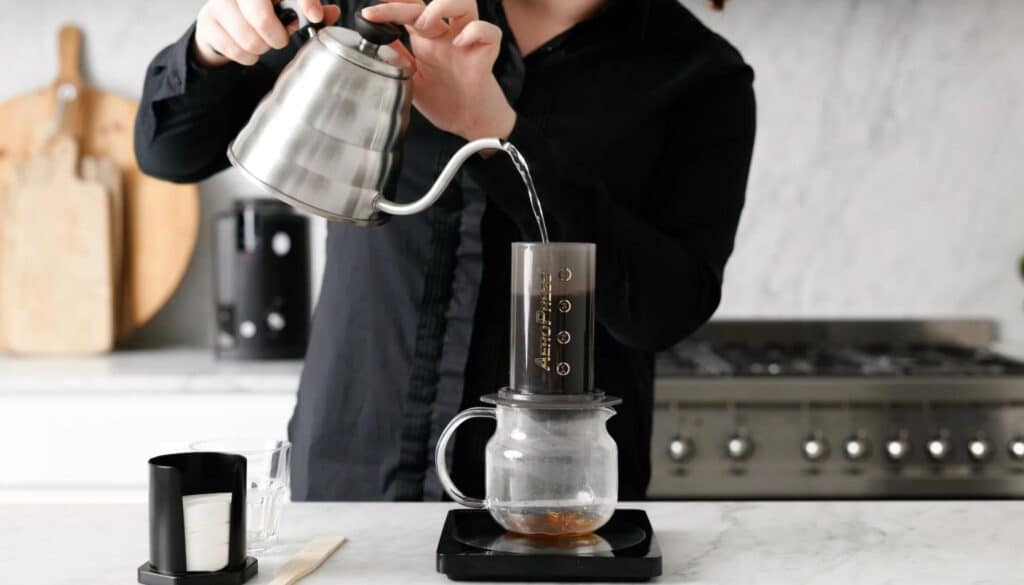
The science behind AeroPress coffee revolves around the principles of extraction, the process by which water pulls flavors and compounds out of coffee grounds. This extraction process is influenced by various factors, including grind size, water temperature, and brewing time, each playing a pivotal role in shaping the final cup’s flavor profile. Understanding these variables provides insight into why the AeroPress can produce such a distinctive and customizable coffee experience, setting it apart from other brewing methods like drip, French press, and espresso.
Extraction Process and Variables
- Extraction Process: The AeroPress utilizes a combination of immersion and pressure to extract flavors from coffee grounds. During the immersion phase, coffee grounds are fully saturated, allowing water to dissolve and extract soluble compounds. The application of pressure through the plunger then accelerates this process, enhancing the extraction efficiency and allowing for a faster brew time.
- Variables:
- Grind Size: Finer grinds increase the surface area in contact with water, speeding up extraction. However, too fine a grind can lead to over-extraction and bitterness. Conversely, a coarser grind slows down extraction, risking under-extraction and a weak, sour taste if not adjusted correctly. AeroPress’s flexibility with grind size allows users to find the perfect balance for their taste.
- Water Temperature: Hotter water speeds up extraction by providing more energy to break down coffee compounds but can lead to over-extraction if too hot. Cooler water slows the process, potentially resulting in under-extraction. The optimal range for AeroPress is often cited as 175°F to 185°F, offering a balanced extraction without scalding the coffee.
- Brewing Time: The AeroPress’s brewing time is generally quick, ranging from 1 to 2 minutes. This short brewing time is made possible by the pressure applied during extraction, which can be adjusted to extract more quickly or slowly, depending on the desired flavor intensity and balance.
Comparison with Other Brewing Methods
- Drip Coffee: Drip brewing relies on gravity to pass water through coffee grounds, often resulting in a longer brewing time and less control over extraction variables. While drip coffee can produce a consistently good cup, it lacks the AeroPress’s versatility and rapid extraction capability.
- French Press: Like the AeroPress, the French press uses immersion brewing but without the application of pressure. This method typically requires a longer brewing time (about 4 minutes) and can leave some sediment in the cup due to its coarser filter. The AeroPress offers a cleaner cup with more control over extraction strength and speed.
- Espresso: Traditional espresso machines use high pressure to force hot water through finely ground coffee, producing a concentrated shot. While the AeroPress cannot achieve the same level of pressure as an espresso machine, it can produce a strong, espresso-like coffee concentrate. The AeroPress is more portable, affordable, and easier to clean than most espresso machines, making it accessible for home use without sacrificing the quality of the coffee.
The AeroPress’s unique ability to quickly and efficiently extract coffee, combined with its adaptability to various brewing variables, makes it a versatile and beloved tool among coffee enthusiasts. Its design allows for an unparalleled level of control over the brewing process, enabling users to fine-tune their coffee to their exact preferences, something that is more challenging to achieve with other brewing methods.
AeroPress Championships and Community

The AeroPress Championships, officially known as the World AeroPress Championship (WAC), have played a pivotal role in not only showcasing the versatility of the AeroPress but also in fostering a vibrant and innovative community of coffee enthusiasts around the globe. Since its inception in 2008, the championship has evolved from a small gathering in Oslo, Norway, to an international event that attracts competitors from dozens of countries, each sharing a common passion for crafting the perfect cup of coffee with an AeroPress.
Overview of the AeroPress Championships
The World AeroPress Championship is an annual competition that celebrates creativity, innovation, and community in coffee brewing. Competitors are tasked with making the best cup of coffee using an AeroPress, with each participant free to choose their coffee beans, water, grind size, brewing method, and other variables. Judges at the event taste the coffee anonymously and select the winners based on the flavor, aroma, and overall quality of the coffee produced. The championship has grown to include national and regional competitions, culminating in a global final where the world champion is crowned.
How Competitions Have Shaped Brewing Methods
The AeroPress Championships have significantly influenced AeroPress brewing methods, encouraging experimentation and innovation among participants. Competitors have introduced a variety of techniques, including adjustments in water temperature, grind coarseness, agitation, steep times, and even the orientation of the AeroPress itself (such as the inverted method). These creative methods have not only challenged traditional coffee brewing norms but have also contributed to a deeper understanding of how different variables affect the taste and quality of the coffee. Many of these techniques have been adopted by the broader AeroPress community, enhancing the coffee brewing experience for casual users and enthusiasts alike.
The Role of Community in Spreading AeroPress Popularity
The community that has formed around the AeroPress and its championships plays a crucial role in the device’s growing popularity. This community, united by a shared enthusiasm for coffee and innovation, spreads across online forums, social media, coffee blogs, and cafes worldwide. Through these platforms, AeroPress users exchange brewing tips, recipes, and personal experiences, fostering a collaborative environment that encourages learning and experimentation.
The championships and the broader AeroPress community have also contributed to the device’s cultural impact within the coffee world. Stories of personal brewing experiments, tales from the championships, and the shared joy of discovery have created a sense of belonging among AeroPress users. This communal spirit has not only helped to spread the word about the AeroPress but has also imbued it with a cultural significance that transcends its function as a coffee maker, making it a symbol of innovation, exploration, and community within the global coffee scene.
The AeroPress Championships and the vibrant community that has emerged around the AeroPress have been instrumental in popularizing the device and pushing the boundaries of coffee brewing. By fostering a culture of experimentation, sharing, and camaraderie, they have enriched the coffee experience for enthusiasts around the world, making the AeroPress more than just a tool for making coffee, but a conduit for connection and creativity within the coffee community.
Tips for Mastering the AeroPress
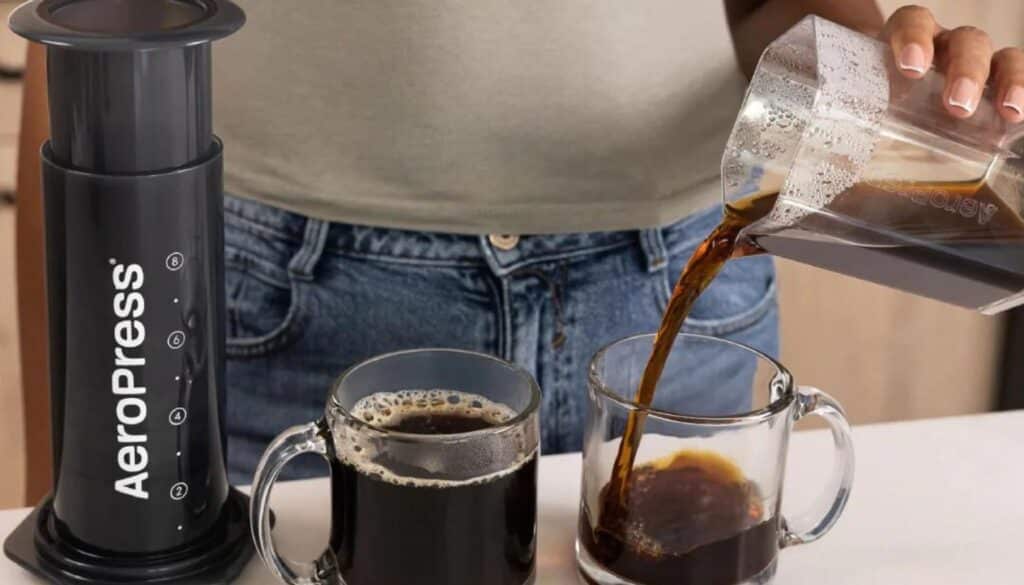
Mastering the AeroPress involves not just understanding how to use it but also how to experiment with various factors that influence the taste and quality of your coffee. Here are some tips for getting the most out of your AeroPress, from selecting the right coffee beans to fine-tuning your brewing process with the help of some recommended accessories.
Choosing the Right Coffee Beans
- Freshness: Start with fresh, high-quality beans. Coffee beans are best used within a few weeks of their roast date to ensure maximum flavor.
- Roast Profile: Experiment with different roast profiles to find what you prefer. Lighter roasts typically offer more acidity and complexity, while darker roasts give a fuller body and richer flavor.
- Origin and Variety: Beans from different origins and varieties bring unique flavors and aromas. Single-origin beans can provide a distinct taste characteristic of their region, while blends can offer a balanced and consistent flavor.
Grinding Techniques for Optimal Extraction
- Grind Size: The grind size should match your brewing method. For the AeroPress, a medium-fine grind is a good starting point, but feel free to adjust finer or coarser depending on the extraction and flavor profile you’re aiming for.
- Consistency: Use a burr grinder for a consistent grind size. Consistent grounds are crucial for even extraction, ensuring every cup of coffee is balanced and delicious.
- Timing: Grind your beans right before brewing to preserve the coffee’s freshness and aroma.
Experimenting with Recipes and Ratios
- Coffee-to-Water Ratio: Begin with a standard ratio, such as 1:15 (coffee to water by weight), and adjust according to taste. More coffee for a stronger brew, less for a lighter one.
- Brewing Time: Adjust the brewing time to explore different extraction levels. Shorter times yield a brighter, lighter cup, while longer times produce a stronger, more developed flavor.
- Temperature and Agitation: Play with water temperature (between 175°F and 205°F) and stirring or agitation techniques to influence the extraction rate and overall flavor profile.
Accessory Recommendations
- Filters: Experiment with paper versus metal filters. Paper filters produce a cleaner cup with less body, while metal filters allow more oils and fine particles through, resulting in a fuller-bodied coffee.
- Grinders: Invest in a quality burr grinder for consistent grinds. The uniformity of the grind size is crucial for predictable and repeatable results.
- Scales: Use a digital scale to measure your coffee and water accurately. Precision in ratios is key to replicating and refining your favorite recipes.
- Temperature-Controlled Kettle: A kettle with temperature control can help you consistently hit the ideal water temperature for brewing.
Mastering the AeroPress is a journey of discovery, where experimentation and adjustment allow you to tailor your brewing method to your personal taste preferences. By focusing on the quality of your beans, refining your grinding technique, experimenting with brewing parameters, and utilizing the right accessories, you can elevate your AeroPress coffee to new heights, enjoying a perfectly crafted cup every time.
Conclusion
The AeroPress really shines in the coffee world because of how simple, versatile, and great at making coffee it is. Its special design mixes soaking the coffee and squeezing it out under pressure. This makes the coffee quickly and brings out rich flavors, setting it apart from older ways like drip coffee, French press, and espresso. This smart way of making coffee cuts down on bitter and sour tastes, giving you a smoother drink.
What makes the AeroPress really special is how it lets people play around with lots of different things, like how fine the coffee is ground, the water’s temperature, how long you brew it, and how you brew it. Whether you want a strong shot like an espresso or a lighter, American-style cup, the AeroPress can do it all. Because it’s so adaptable, easy to clean, and easy to carry, coffee fans everywhere, from beginners to expert baristas, love it.
The AeroPress has a big community that loves sharing tips, recipes, and ways to make coffee. This love for sharing and trying new things has helped make the AeroPress popular. It encourages new people to try it out and those who already have one to get even better at using it.
As you start or keep going with your AeroPress adventure, remember that trying new things is key to getting really good at it. Every little change you make helps you find your perfect cup of coffee. The AeroPress isn’t just for making coffee; it’s a chance to dive into the huge, detailed world of coffee tastes and ways to make it. Take this chance to try new things, share what you find with others, and most of all, enjoy the amazing coffee you make. With the AeroPress, you’re on your way to exploring coffee cultures from around the world, one press at a time.
References and Further Reading
- AeroPress. (n.d.). AeroPress. Retrieved from https://aeropress.com/
- AeroPress. (n.d.). How it works. Retrieved from https://aeropress.com/pages/how-it-works
- AeroPress. (n.d.). Science. Retrieved from https://aeropress.com/pages/science

